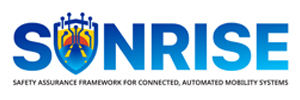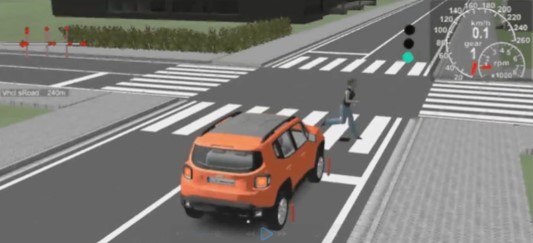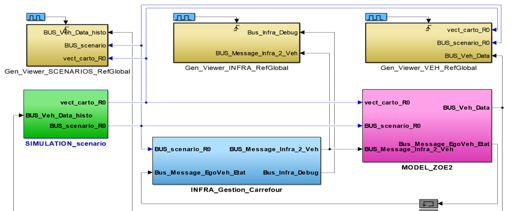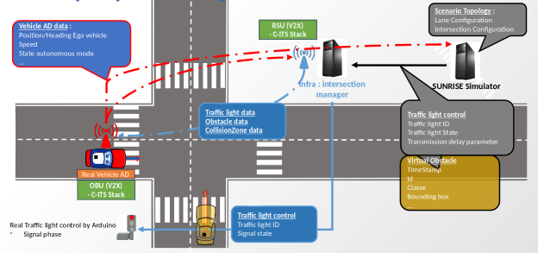UC1.2 – Connected Perception Testing
In Use Case 1.2, the SUNRISE SAF is tested for cooperative perception and decision-making in urban intersection scenarios. The system under test is a cooperative Adaptive Cruise Control (ACC) that is expected to improve with enhanced perception obtained through Vehicle to Everything (V2X) connectivity.
There are four functional scenarios defined in T7.1. Three of these scenarios involve improving vehicle behaviour when approaching a traffic light and receiving present and future traffic light phases, timings, and map information. The scenarios cover three types of unexpected events: a baseline scenario with no unexpected event, a violation by a distracted pedestrian, and a reset of phases due to a pedestrian call. The fourth scenario deals with a red-light violation by a crossing car, and in this case, V2V information complements the traffic light connection.
Use case overview
Demonstrate a comprehensive safety argument for urban pilots, emphasizing perception testing and specifically addressing current gaps related to extended virtual perception through V2X cooperation. This should include operational design domain (ODD) and scenario coverage, which incorporates connectivity with vehicles ahead and infrastructure, particularly connected traffic lights.

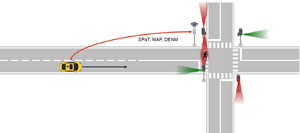
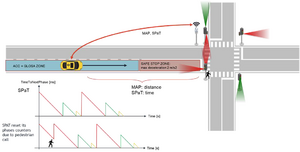
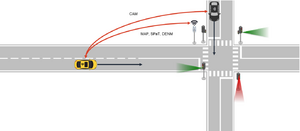
Objectives
- UC1.2-A: This Use Case evaluates the conditions (distance and velocity) under which a vehicle can safely stop after receiving the traffic light phases.
- UC1.2-B: Demonstrate how safety and surrounding awareness can be improved on highways by including cooperative V2X communication with surrounding infrastructure.
- UC1.2-D: The scope is to test an Automated Driving System (ADS) vehicle at an urban intersection equipped with an Intersection Moving Assist (IMA) system and analyse red light violation.
SAF blocks demonstrated

Safety case setup
- UC1.2-B
- CCAM system under test: Cooperative-advanced ACC including augmented perception that integrates information about traffic light current and future states transmitted via V2X communications (SAE Level 1+)
- Operational Design Domain: Urban intersection
- Test environments employed
Simulation in IPG CarMaker

- UC1.2-D
- CCAM system under test: Automated Driving System (ADS) with V2X capabilities for Intersection Management Assistance (IMA).
- Operational Design Domain: Urban intersection environment with signalized traffic lights, moderate traffic conditions, daytime, dry weather, and functioning V2X roadside infrastructure (RSU)
- Test environments employed
Virtual Testing Framework: MATLAB, Simulink

Hybrid Testing Framework: Omnet++,Veins, SUMO, Real ADS Vehicle, real IMA system, real test track

Test environments
- UC1.2-B
Traffic light violation by pedestrian - UC1.2-D
An ADS vehicle approaches a signalized urban intersection, receiving real-time SPATEM messages from an RSU. It adjusts its speed to stop at red and move on green, showcasing safe intersection handling using V2X.
Traffic Light Scenarios (SPATEM & IMA):- Nominal Stop
- Restart on Green
- Signal Failure Handling
Intersection Management (IMA Logic):
- Yield to Priority Obstacle
- Yield to Non-Priority Obstacle
Safety case building
UC1.2-B
- Safety evidence:
- Microscopic evaluation (on individual scenarios) of pass/fail results
- Macroscopic evaluation (statistical analysis) of aggregated results
- Derivation of a safe speed recommendation function
- Coverage-oriented testing
- Risk-oriented testing
- High-risk scenarios identification
- Boundary scenarios identification
- Safe approach speed recommendation
UC1.2-D
- Safety evidence: Microscopic evaluation (on individual scenarios) of pass/fail results
- Safety case pass/fail binary result
- Co-simulation framework execution
- Risk-oriented testing: Boundary scenarios identification
- Modular approach: Independent subsystems & End-to-end system testing (Open-Loop / Closed-Loop)
- Aggregate metrics for selected scenarios: criticality, complexity, exposure, coverage
- Combine results from different test environments to argue ‘macroscopic’ safety margin violation for one logical scenario
- Verification of simulation results through Hybrid testing
Test scenarios selected
The main scenarios include:
- traffic light violation
- traffic light phases reset
- pedestrian violating the red light
- another crossing vehicle violating the red light
